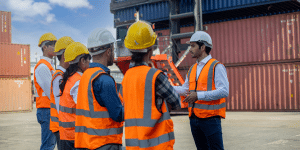TAKEAWAY: According to a study conducted by The Institute for Work and Health (IWH), employers in the construction industry can realize an average of 36% return on their investments in health and safety. Here’s how…
Jump Ahead
While many employers recognize the benefits of investing in occupational health and safety, including occupational testing, until recently, those benefits have been hard to quantify. However, a new study conducted by The Institute for Work and Health (IWH) has put a number to those benefits. And according to the study authors, employers in the construction industry can realize an average of 36% return on their investments in health and safety. The authors concluded that the scale of employer expenditures to protect workers’ health is a prominent factor contributing to reducing work-related injury and illness.
Occupational testing was born from the desire to tie data-driven metrics to occupational health and safety efforts. However, these efforts have begun to have a much more critical impact on workplace health and safety cultures. Despite a general acceptance of its usefulness, the breadth of the positive effects of occupational testing on health and safety culture has always been a challenge to quantify. However, recent studies, including the IWH research, have begun to demonstrate the critical importance of this type of testing in supporting and fostering a robust health and safety culture, particularly in the construction industry.
Construction Industry Challenges
The construction industry has some unique challenges in that it is one of the frequent sources of workplace accidents and a frequent target of worksite regulators on both sides of the border. Noise, chemical hazards, and dust put construction workers at increased risk for hearing loss and lung disease. In addition, illicit drug and alcohol use is often higher in this industry than in many others. In fact, construction workers are almost twice as likely as the general population to have a substance abuse problem. Opioids account for 20% of the total spending of construction workers on prescription drugs, higher than any other industry.
The high number of transient workers in this industry, and those moving from employer to employer, exacerbates these risks and increases employers’ challenges face in trying to mitigate them.
A focus on prevention rather than punishment
Just 56% of construction workers have access to paid sick benefits. Injured workers often feel pressure, financial and otherwise, to return to work quickly, often before they are ready. As a result, the opioid crisis has hit construction particularly hard. A growing number of companies and unions are leveraging drug testing not as a punitive measure but instead using it to identify workers who need help. For example, members of the local carpenters’ union in St. Louis are no longer fired for positive drug test results. Instead, they can return to work provided they complete mandatory training. According to National Safety Council research, this approach is paying off, saving employers up to $8,175 in turnover, replacement, and healthcare costs.
Occupational testing puts a focus on preventing injuries rather than punishing workers for errors in judgment.
Recent research has revealed that construction workers are more likely than workers in other industries to use drugs. This puts these workers and the public in danger and exposes employers to liabilities and additional risks. Occupational testing can protect people and mitigate risks for companies, but it does more than that. It can also help identify workers dealing with a problem and allow employers to offer help. Recently, a related study revealed that workplace drug testing, in conjunction with clinical monitoring and oversight, does reduce use and spending on prescription and illegal drugs.

Employee SAP Programs | SureHire
SureHire’s Substance Abuse Professionals (SAPs) are here to help employers assess workers who have disclosed a substance abuse problem or tested positive on a drug and alcohol test. They also help you and your employees chart a legal and productive path forward.
Occupational Testing Delivers Individualized, Targeted Metrics
Prevention is the focus of both audiometric testing and lung health monitoring. These tests seek to identify and mitigate issues and exposures before the damage becomes debilitating.
Occupational noise-induced hearing loss (NIHL) is degenerative, irreversible, and almost entirely preventable. It’s a known hazard on construction sites from noisy tools and equipment and exposure to dangerous chemicals.
In British Columbia alone, more than 400 construction workers report hearing issues yearly, costing more than $5 million annually on hearing aids and services. In response, the province is setting up a system to track and monitor hearing loss and damage in construction workers. This mirrors statistics the CDC revealed that 16% of construction workers suffered some degree of hearing impairment, second only to mining.
Regular audiometric testing, starting with a baseline reading, is the key to preventing these statistics. It can help identify small changes in hearing. Informing workers about these changes can spur them to make better use of PPE and encourage employers to ensure better education and training in hearing loss prevention. The Centers for Disease Control (CDC) has called attention to the prevalence of hearing loss in the construction industry, noting that “without testing to identify workers losing their hearing, intervention might be delayed or might not occur.”
Other studies have supported the CDC’s stance on occupational testing. In one particular study, annual testing led over half of the participants to change their work habits and improve their job and home hearing protection use.
Research has confirmed similar results with lung health monitoring. In fact, one recent study predicted that intervention methods, including increased testing, could help reduce incidents of lung cancers by 11% in the coming years.

Audiometric Testing & PPE | SureHire
SureHire offers both baseline and periodic audiometric testing to help employers prevent occupational NIHL on the job and monitor their employees’ overall health and wellbeing. We also offer custom molded hearing protection to mitigate risk even further.
A focus on ensuring compliance and protecting workers
Fit testing can also help prevent lung health problems by ensuring masks and other protective devices fit workers well enough to be effective. It is required both by Canadian Safety Association (CSA) standards and by Occupational Safety and Health Association standards. Taking the time to respiratory PPE adequately protects workers from unnecessary harm. It can protect employers from unnecessary financial and other penalties. Unsurprisingly, lack of fit testing was cited in nearly 3000 violations issued by the Occupational Safety and Health Association in 2019. It is considered the fifth most frequently cited standard.
Proper fit also ensures comfort, and interestingly, a lack of comfort. Construction workers often cite discomfort as why they fail to wear the PPE they’re given, despite understanding the dangers inherent in their work. The new standards for the CSA emphasized comfort. This vital consideration ensures PPE will be used and effective in protecting workers.
Safety training builds on occupational testing
Testing programs can deliver the why for prevention and treatment to both workers and employers. While the construction industry provides more job skills and career training than other industries, not surprisingly, 55% of construction workers believe they need more safety training.
Training and awareness programs extend the value by delivering the how. Construction is a dangerous business, but employers can control those risks with a combination of occupational testing and appropriate training.
Occupational testing offers tremendous value to workers and employers in the construction industry, reducing accidents, injuries, and absenteeism, lowering healthcare costs, and enhancing productivity.

SureHire Occupational Testing
If you’re looking for a trusted provider to help you improve your safety culture and keep your workforce safe, healthy, and productive. Contact us today!
You May Also Be Interested In…
- SureHire Occupational Testing Acquires COHR Health: A Positive Step Towards Safe, Healthy, Productive Workforces and CommunitiesWe are thrilled to announce that today, May 6, 2024, SureHire Occupational Testing has officially acquired COHR Health, a well-known leader in occupational health services. Read on…
- Occupational Testing Use Case – Mining
 In this case study, we will explore how mining companies can use various types of occupational tests to reduce Total Recordable Incident Rates (TRIR) long term.
In this case study, we will explore how mining companies can use various types of occupational tests to reduce Total Recordable Incident Rates (TRIR) long term. - 9 Strategies to Keep Workers Cool on Drilling Sites During Hot Summer Months
 This article delves into strategies to keep workers cool and safe on drilling sites during the hot summer months.
This article delves into strategies to keep workers cool and safe on drilling sites during the hot summer months. - Hearing Conservation Basics: How to Manage Occupational Noise
 Learn how to proactively mitigate occupational noise risks and help prevent NIHL among workers.
Learn how to proactively mitigate occupational noise risks and help prevent NIHL among workers. - Occupational Testing Use Case – Manufacturing
 Explore how manufacturing companies can use various types of occupational testing to assess job applicants, including statistics that show how that can reduce your Total Recordable Incident Rate over the long term.
Explore how manufacturing companies can use various types of occupational testing to assess job applicants, including statistics that show how that can reduce your Total Recordable Incident Rate over the long term. - How to Improve Workplace Safety Communication: Seven Strategies for Success
 This article explores seven practical strategies to improve workplace safety communication. From regular training sessions to utilizing various communication channels, these approaches will enhance the effectiveness of safety messages and ensure they reach and resonate with every employee.
This article explores seven practical strategies to improve workplace safety communication. From regular training sessions to utilizing various communication channels, these approaches will enhance the effectiveness of safety messages and ensure they reach and resonate with every employee.

